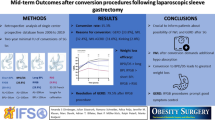Background: Laparoscopic sleeve gastrectomy (LSG) started as the restrictive part of the more complex laparoscopic duodenal switch (LDS) operation. There is no long-term experience with the isolated LSG. The main concern about the isolated LSG is the possibility of dilatation of the gastric pouch, long-term loss of restrictive function and weight regain. Laparoscopic re-sleeve gastrectomy (LRSG) has been used sparingly, but it also may become a possibility if more patients have the isolated LSG. Methods: 2 patients with BMI 58 and 65 respectively, underwent LSG as the first stage of the LDS. Later, when the patients regained some weight and their gastric pouch was found to be too large, the LRSG/DS was done. Results: The patient with BMI 58 had an initial drop to BMI 34 and regained weight to BMI 46, but after the LRSG/DS her BMI is 36 at 4 months. The BMI patient with BMI 65 had a drop to BMI 42, and after the LRSG/DS his BMI is 33 at 3 months later. Conclusion: LRSG may become necessary after gastric tube dilatation or insufficient original gastric volume reduction. LRSG is feasible, available and easy to perform when the resulting gastric pouch is too large or dilates after the original LSG.
Similar content being viewed by others
Author information
Authors and Affiliations
Rights and permissions
About this article
Cite this article
Baltasar, A., Serra, C., Pérez, N. et al. Re-Sleeve Gastrectomy. OBES SURG 16, 1535–1538 (2006). https://doi.org/10.1381/096089206778869924
Published:
Issue Date:
DOI: https://doi.org/10.1381/096089206778869924




